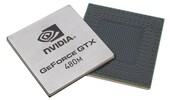NVIDIA GeForce GTX 485M vs NVIDIA GeForce GTX 480M
NVIDIA GeForce GTX 485M
► remove from comparisonThe Nvidia GeForce GTX 485M is the fastest graphics card for laptops at the time of announcement (Q1 2011). It is based on the GF104 chip and offers all 384 shader cores and the full 256 Bit memory bus. Due to the high clock rate of 575 MHz, it is significantly faster than the old GeForce GTX 480M of which it replaces. It also supports DirectX 11 and OpenGL 4.0.
Other than the GeForce GTX 480M, the 485M is no longer based on a trimmed down GF100 chip, but on the related GF104 instead. The GF104 is designed for the consumer sector and has a total of 384 cores. A number of cores may be disabled, for example the 470M with only 288 active cores.
The technology of the GF104 differs quite a bit from the GF100 chip (which was actually designed for professional use). The GF104 has more shaders (3x16 vs. 2x16), texture units (8 vs. 4) and SFUs (Special-Funciton-Units) per Streaming-Multiprocessors (SM). Nvidia now uses the superscalar architecture as there are still only two warp schedulers supporting three shader blocks. In theory, this helps to utilize the shaders more efficiently and increases the performance per core.
However, in the worst case, the performance can drop below the GF100 architecture (and its predecessors). The ECC memory protection, important in professional applications, was completely omitted and the FP64 was trimmed down (only 1/3 of the shaders are FP64-capable, only 1/12 of the FP32 performance). Because of these reductions in the GF104, the size of a SM increased only by 25% despite the higher number of shaders.
Note that it is not possible to directly compare the number of cores to the AMD Radeon graphics cards (e.g. HD 5870) or even to Nvidia's own predecessors (e.g., G92b), because shader architecture and clock rates are significantly different in the GF104 chip.
Performance
In our extensive test of the GeForce GTX 485M, we found that the GTX485M is significantly faster than the old GeForce GTX 480M (at the same TDP rating). The performance is on a level with two GeForce GTX 460M in SLI mode. Nearly all games are therefore playable in highest details and resolutions. Even demanding games like Mafia 2 or Battlefield Bad Company 2 can run fluently in 1080p with maximus detail settings. Detailed benchmarks can be found at the end of this page.
Features
What's new compared to the GF100 is support for Bitstream transfer of HD Audio (Blu-Ray) via HDMI in the GF104 chips. Similar to the HD 5850, the GTX 485M can transmit Dolby True HD and DTS-HD via Bitstream to compatible receivers without quality loss.
For decoding HD videos, the GTX485M supports PureVideo HD. The built-in Processor 4 (VP4) handles Feature Set C. As a result, MPEG-1, MPEG-2, MPEG-4 Part 2 (MPEG-4 ASP - z.B. DivX or Xvid), VC-1/WMV9 and H.264 can be fully decoded by the graphics card (VLD, IDCT, Motion Compensation, and Deblocking). Furthermore, two streams can be simultaneously decoded in realtime, e.g. Blu-Ray Picture-in-Picture (2x1080p lt DXVAChecker). In addition, PureVideo HD indicates HDCP encoding for digital interfaces.
The shader cores (also called CUDA cores) can also be used for general computations (e.g. Video Transcoding) by using the interfaces CUDA, DirectCompute 2.1 or OpenCL. Thanks to PhysX, the 485M can also perform physics calculations.
According to Nvidia, the support for 3D Vision includes support for the recent HDMI 1.4a standard as well. If enabled by the laptop manufacturer, content such as 3D games, 3D web streaming videos, 3D pictures and 3D Blu-Ray videos can be displayed on a 3D-capable TV (via discrete 3DTV Play) or on the internal notebook 3D display.
With regards to energy demand, the GTX 485M should be on par with the GeForce GTX 480M. In other words, both graphics cards should draw about 100 Watts each when including their respective memory and MXM boards. Due to the higher performance from the 485M, the performance/power efficiency here has clearly been improved.
Compared to desktop graphics cards, the performance of the 485M should be on par with a GeForce GTX 460 768MB which features less cores but operates on higher clock rates.
NVIDIA GeForce GTX 480M
► remove from comparison
The NVIDIA GeForce GTX 480M is a high-end graphics card for laptops based on the Fermi architecture. As a result, it supports DirectX 11 and is produced in 40nm at TSMC. Featuring 352 cores, the GTX480M is similar to the desktop GTX 465 but with a lower clock rate. The GeForce GTX 480M is combined with 2 GB of fast dedicated GDDR5 graphics memory and the overall performance should be generally superior to the Mobility Radeon HD 5870.
The GF100 (aka. Fermi) chip was redesigned from scratch and features 3 billion transistors, assuming all 512 shaders are present. Compared to the desktop HD 5870 with 2.13 billion transistors or the Mobility Radeon HD 5870 (RV870) with 1.04 billion transistors, the GTX 480M die is physically quite large.
The mobile Fermi chip is stripped down to 352 shader cores (1-dimensional) with 32 ROPs and 44 Texture Units. The memory bus is 256 bit wide, but due to the fast GDDR5 memory, this should not be a bottleneck. The power consumption has been specified to 100 Watt TDP when taking into account the MXM board and the 2 GB GDDR5. AMD usually specifies the TDP of the chip alone, therefore this value is not directly comparable with competing Radeon cards. Still, the GTX 480M is only suited for very large desktop replacement (DTR) laptops with an excellent cooling solution. Originally, only Clevo was offering the GTX 480M in its 17" (D901F) and 18" (X8100) barebones.
The performance of the Nvidia GeForce GTX 480M is about 10% better on average than the ATI Mobility Radeon HD 5870. In demanding DirectX 11 games and benchmarks (that make use of the Tessellation engine), the GTX 480M is even faster. That means the GTX480M is the fastest single GPU graphics solution for laptops as of early to mid 2010. Modern DirectX 10 games should run fluently in high resolutions and details with antialiasing. Only very demanding games like Crysis or Metro 2033 may need some reduced settings (see list below). Due to the DirectX 11 hardware support (and the good tessellation implementation), the Fermi based laptop graphics card should be well suited for upcoming DirectX 11 games.
As the GeForce 300M series, the GeForce GTX 480M supports PureVideo HD with VideoProcessor 4 (VP4 with Feature Set C). This means the GPU is able to fully decode HD videos in H.254, VC-1, MPEG-2, and MPEG-4 ASP. The graphics card can also accelerate Flash videos by using Flash 10.1 or greater.
The rendering cores of the Nvidia GeForce GTX 480M can be used for general calculations with CUDA or DirectCompute. For example, the encoding of HD videos can be done significantly faster than most modern CPUs by using the shader cores of the GPU instead. PhysX is also supported by the mobile Fermi chip to calculate physics effects in supported games.
Compared to desktop GPUs, the Geforce GTX 480M is comparable to a nunderclocked Nvidia GeForce GTX 465 (607/1200 clock speed) and is therefore on par with a desktop Radeon HD 5770.
| NVIDIA GeForce GTX 485M | NVIDIA GeForce GTX 480M | |||||||||||||||||||||||||||||||||||||||||||||||||
| GeForce GTX 400M Series |
|
| ||||||||||||||||||||||||||||||||||||||||||||||||
| Codename | N12E-GTX-A1 | N11E-GTX-A3 | ||||||||||||||||||||||||||||||||||||||||||||||||
| Architecture | Fermi | Fermi | ||||||||||||||||||||||||||||||||||||||||||||||||
| Pipelines | 384 - unified | 352 - unified | ||||||||||||||||||||||||||||||||||||||||||||||||
| Core Speed | 575 MHz | 425 MHz | ||||||||||||||||||||||||||||||||||||||||||||||||
| Shader Speed | 1150 MHz | 850 MHz | ||||||||||||||||||||||||||||||||||||||||||||||||
| Memory Speed | 1500 MHz | 1200 MHz | ||||||||||||||||||||||||||||||||||||||||||||||||
| Memory Bus Width | 256 Bit | 256 Bit | ||||||||||||||||||||||||||||||||||||||||||||||||
| Memory Type | GDDR5 | GDDR5 | ||||||||||||||||||||||||||||||||||||||||||||||||
| Shared Memory | no | no | ||||||||||||||||||||||||||||||||||||||||||||||||
| API | DirectX 11, Shader 5.0 | DirectX 11, Shader 5.0 | ||||||||||||||||||||||||||||||||||||||||||||||||
| Power Consumption | 100 Watt | 100 Watt | ||||||||||||||||||||||||||||||||||||||||||||||||
| technology | 40 nm | 40 nm | ||||||||||||||||||||||||||||||||||||||||||||||||
| Notebook Size | large | large | ||||||||||||||||||||||||||||||||||||||||||||||||
| Date of Announcement | 06.01.2010 | 25.05.2010 | ||||||||||||||||||||||||||||||||||||||||||||||||
| Max. Amount of Memory | 2048 MB | |||||||||||||||||||||||||||||||||||||||||||||||||
| Transistors | 3 Billion | |||||||||||||||||||||||||||||||||||||||||||||||||
| Link to Manufacturer Page | www.nvidia.com |
Benchmarks
3DM Vant. Perf. total + NVIDIA GeForce GTX 485M
specvp11 snx-01 + NVIDIA GeForce GTX 485M
Average Benchmarks NVIDIA GeForce GTX 485M → 100% n=11
Average Benchmarks NVIDIA GeForce GTX 480M → 83% n=11
* Smaller numbers mean a higher performance
1 This benchmark is not used for the average calculation
Game Benchmarks
The following benchmarks stem from our benchmarks of review laptops. The performance depends on the used graphics memory, clock rate, processor, system settings, drivers, and operating systems. So the results don't have to be representative for all laptops with this GPU. For detailed information on the benchmark results, click on the fps number.

Crysis 2
2011
Fifa 11
2010
Mafia 2
2010
StarCraft 2
2010
Metro 2033
2010
CoD Modern Warfare 2
2009Average Gaming NVIDIA GeForce GTX 485M → 100%
Average Gaming 30-70 fps → 100%
Average Gaming NVIDIA GeForce GTX 480M → 75%
Average Gaming 30-70 fps → 69%
| NVIDIA GeForce GTX 485M | NVIDIA GeForce GTX 480M | |||||||||||||
|---|---|---|---|---|---|---|---|---|---|---|---|---|---|---|
| low | med. | high | ultra | QHD | 4K | low | med. | high | ultra | QHD | 4K | |||
| Crysis 2 | 166.6 | 117.5 | 87.8 | 30.3 | ||||||||||
| Call of Duty: Black Ops | 74.3 | 84.2 | 75 | 73 | ||||||||||
| Fifa 11 | 455 | 327 | 271 | 196.9 | ||||||||||
| Mafia 2 | 97.9 | 90.8 | 86 | 59 | 67.1 | 60 | 40.9 | |||||||
| StarCraft 2 | 220.9 | 85.9 | 85.2 | 56.5 | 45.2 | 44.5 | 36.8 | |||||||
| Metro 2033 | 116.2 | 80.8 | 48.12 | 16.1 | 126 | 64 | 33 | 12 | ||||||
| Battlefield: Bad Company 2 | 134.5 | 101 | 52 | 108 | 81 | 64 | 38 | |||||||
| CoD Modern Warfare 2 | 223.7 | 130.9 | 118.4 | 76.3 | 78.6 | 68 | 49 | |||||||
| Risen | 160.3 | 99.9 | 72.6 | 52.7 | 68.4 | 48.7 | 36 | |||||||
| Resident Evil 5 | 140 | 96.9 | 150.5 | 96.3 | 59.7 | |||||||||
| Need for Speed Shift | 141.9 | 106.9 | 100.1 | 70.7 | 74 | 77 | 52 | |||||||
| Colin McRae: DIRT 2 | 159.9 | 138.8 | 124 | 70 | 176.5 | 112 | 83 | 47 | ||||||
| Anno 1404 | 214.2 | 83.3 | 170 | 53 | ||||||||||
| F.E.A.R. 2 | 271.6 | 182.7 | 153.5 | 88.5 | 119 | 61 | ||||||||
| GTA IV - Grand Theft Auto | 65.5 | 63.9 | 62 | 53.9 | ||||||||||
| Left 4 Dead | 184.3 | 121.6 | 142 | |||||||||||
| Far Cry 2 | 192.8 | 141.4 | 68.3 | 174 | 106 | 45.4 | ||||||||
| Supreme Commander - FA Bench | 81.7 | 78.9 | 59.9 | 52.4 | 45.1 | |||||||||
| Crysis - GPU Benchmark | 135.6 | 88.1 | 74.2 | 22.56 | 62.3 | 16.1 | ||||||||
| NVIDIA GeForce GTX 485M | NVIDIA GeForce GTX 480M | |||||||||||||
| low | med. | high | ultra | QHD | 4K | low | med. | high | ultra | QHD | 4K | < 30 fps < 60 fps < 120 fps ≥ 120 fps | 4 13 | 10 5 | 1 12 5 | 2 6 7 1 | | | < 30 fps < 60 fps < 120 fps ≥ 120 fps | 1 5 | 1 7 | 5 9 1 | 2 11 1 | | |
For more games that might be playable and a list of all games and graphics cards visit our Gaming List




































